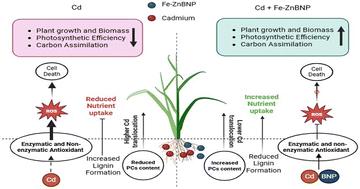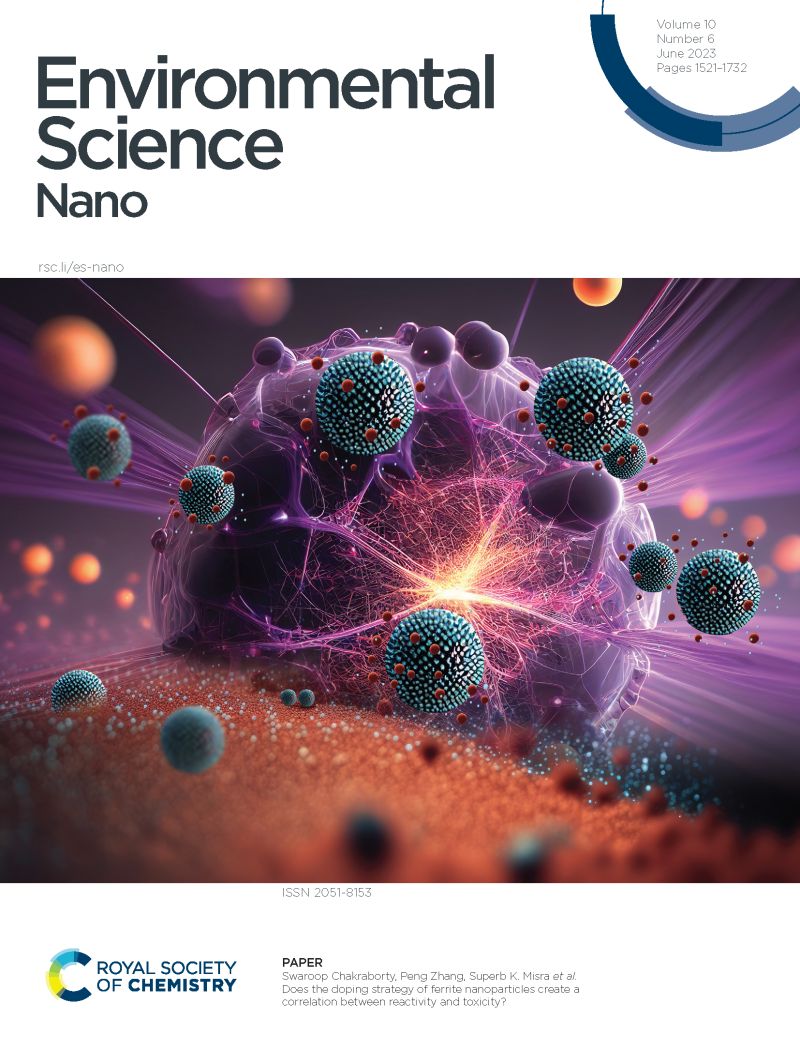绿色合成铁锌双金属纳米颗粒减轻水稻镉积累,促进植株生长。(寄主)
IF 5.1
2区 环境科学与生态学
Q1 CHEMISTRY, MULTIDISCIPLINARY
引用次数: 0
摘要
大米中的镉(Cd)污染造成严重的健康危害并危及食品安全;因此,尽量减少镉的毒性是至关重要的。本文研究了一种新型的绿色合成的铁锌双金属纳米颗粒(Fe-Zn BNP)对镉的修复和促进生长的潜力。采用10 μM CdCl2和Fe-Zn BNPs (25 mg L−1)共处理14日龄籼稻幼苗7 d,评估其生长、胁迫参数和Cd含量。结果表明,铁锌BNPs能有效恢复受损的生长参数(根、茎长、鲜重和干重),提高叶绿素及其前体分子(δ-ALA和PBG),最终使光合效率提高72.21%。ROS的形成和其他应激标志物(MDA,甲基乙二醛)也显著减少。本研究发现,在cd胁迫下,铁锌BNPs处理显著提高了幼苗的铁和锌含量。铁锌BNPs限制了Cd在根尖的定位,并通过植物螯合素介导的Cd固存减少了从根到地上部的转运(地上部占32.38%,根部占42.39%)。同时,Fe - Zn BNPs下调Fe和Zn转运基因OsIRT1、OsZIP1和OsZIP4的表达。因此,本研究为开发一种新型BNP为有效改善水稻镉毒性和改善植物健康提供了一条有希望的途径。本文章由计算机程序翻译,如有差异,请以英文原文为准。

Green-synthesized Fe–Zn bimetallic nanoparticles alleviated cadmium accumulation and enhanced plant growth in Oryza sativa L. cv. (IR64)
Cadmium (Cd) contamination in rice causes severe health hazards and compromises food safety; therefore, it is crucial to minimise Cd toxicity. In the present study, a novel green-synthesized Fe–Zn bimetallic nanoparticle (Fe–Zn BNP) was evaluated for Cd remediation and growth-promoting potential. Fourteen day-old indica rice seedlings were co-treated with 10 μM CdCl2 and Fe–Zn BNPs (25 mg L−1) for seven days and assessed for growth, stress parameters, and Cd content. Results indicated that Fe–Zn BNPs could effectively restore impaired growth parameters (root, shoot length, fresh and dry weight) and elevate chlorophyll and its precursor molecules (δ-ALA and PBG), eventually increasing photosynthetic efficiency by 72.21%. Significant reduction of ROS formation and other stress markers (MDA, methylglyoxal) were also observed. This study revealed a significant increase in Fe and Zn content upon treatment of Cd-stressed seedlings with Fe–Zn BNPs. Fe–Zn BNPs were found to restrict Cd localisation in root apices and reduce translocation from the root to the shoot by phytochelatin-mediated Cd sequestration (32.38% in the shoot and 42.39% in the root). Simultaneously, Fe–Zn BNPs downregulated the expression of Fe and Zn transporter genes OsIRT1, OsZIP1, and OsZIP4. Therefore, this research offers a promising avenue for the efficient amelioration of Cd toxicity in rice and improved plant health by developing a novel BNP.
求助全文
通过发布文献求助,成功后即可免费获取论文全文。
去求助
来源期刊

Environmental Science: Nano
CHEMISTRY, MULTIDISCIPLINARY-ENVIRONMENTAL SCIENCES
CiteScore
12.20
自引率
5.50%
发文量
290
审稿时长
2.1 months
期刊介绍:
Environmental Science: Nano serves as a comprehensive and high-impact peer-reviewed source of information on the design and demonstration of engineered nanomaterials for environment-based applications. It also covers the interactions between engineered, natural, and incidental nanomaterials with biological and environmental systems. This scope includes, but is not limited to, the following topic areas:
Novel nanomaterial-based applications for water, air, soil, food, and energy sustainability
Nanomaterial interactions with biological systems and nanotoxicology
Environmental fate, reactivity, and transformations of nanoscale materials
Nanoscale processes in the environment
Sustainable nanotechnology including rational nanomaterial design, life cycle assessment, risk/benefit analysis
 求助内容:
求助内容: 应助结果提醒方式:
应助结果提醒方式:


